代词用法全解[下学期]
图片预览
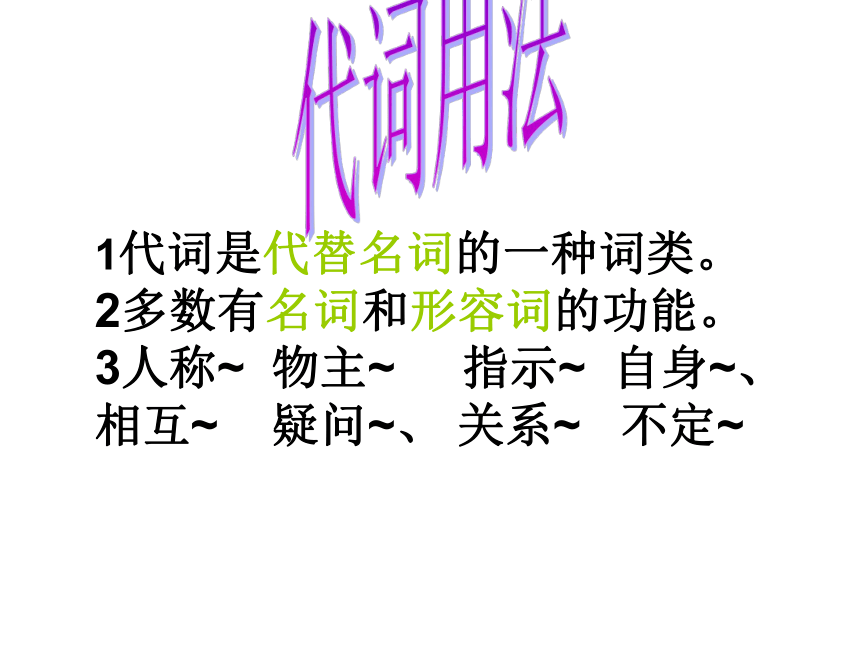
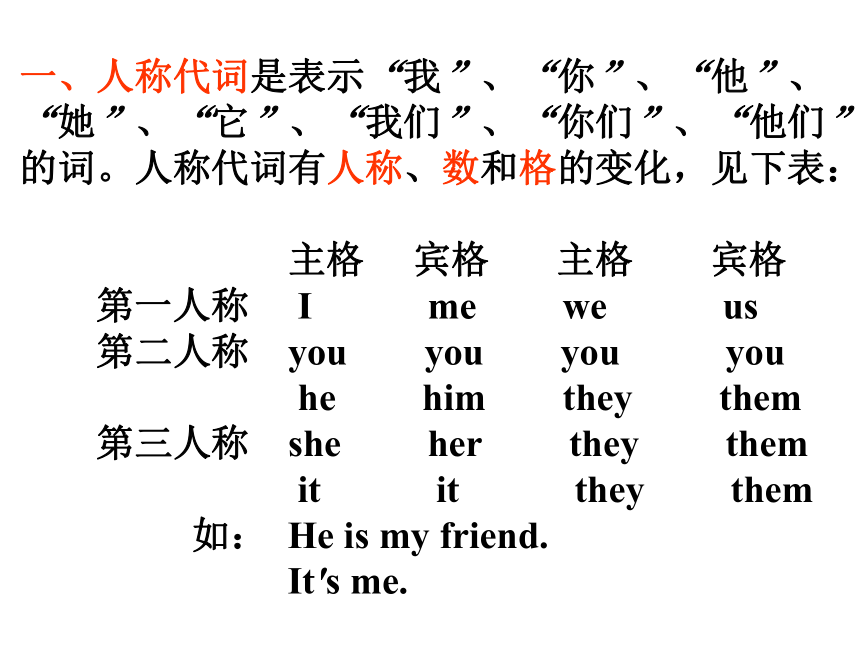
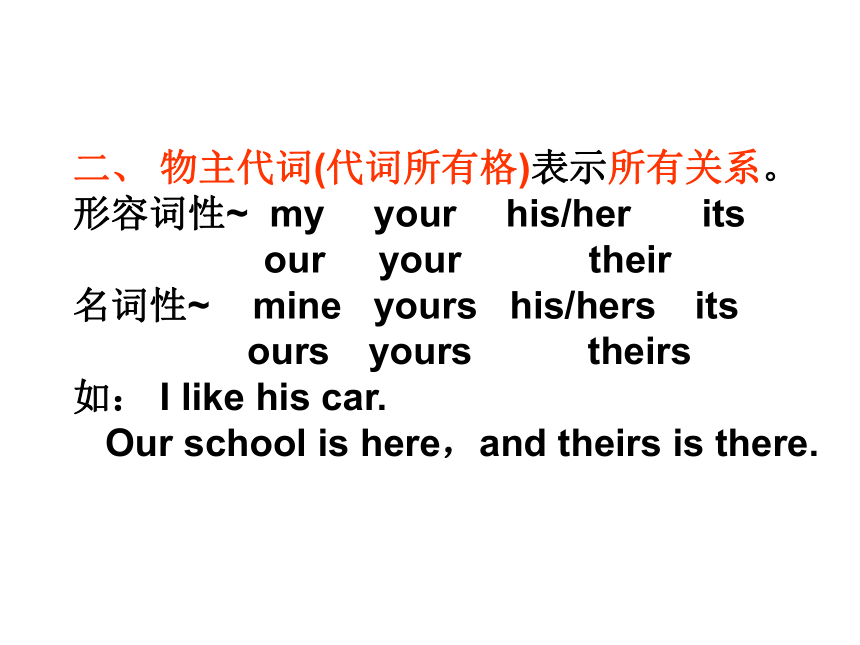
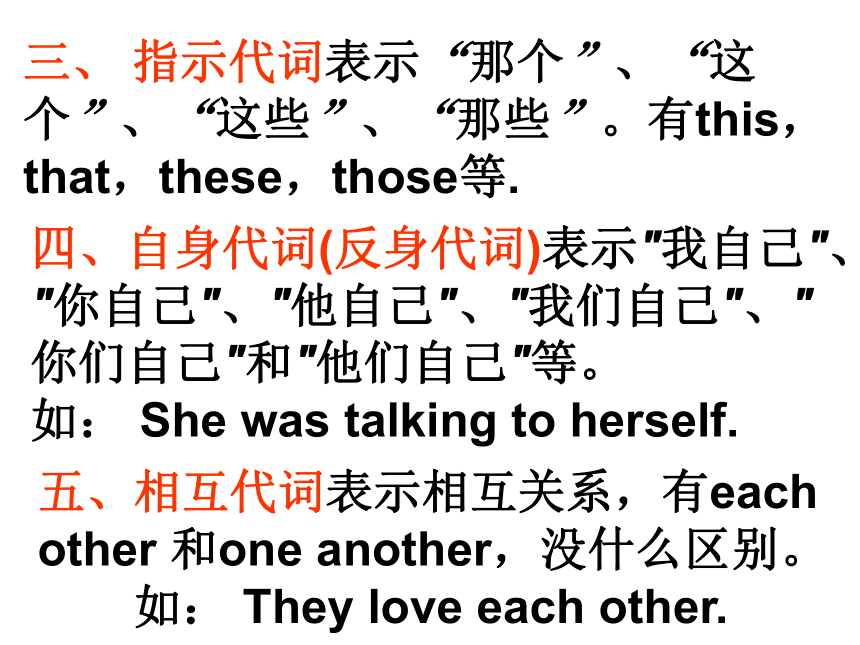
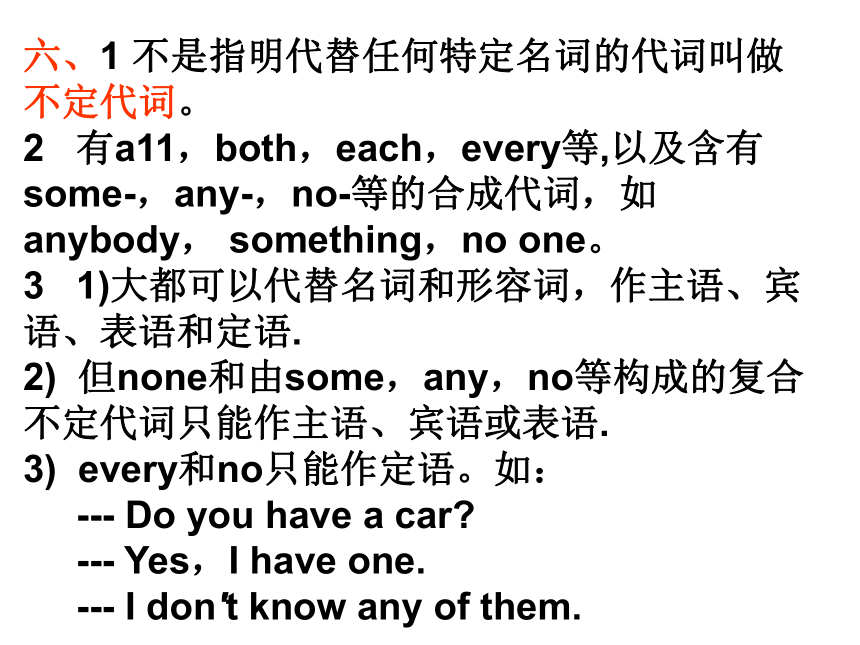
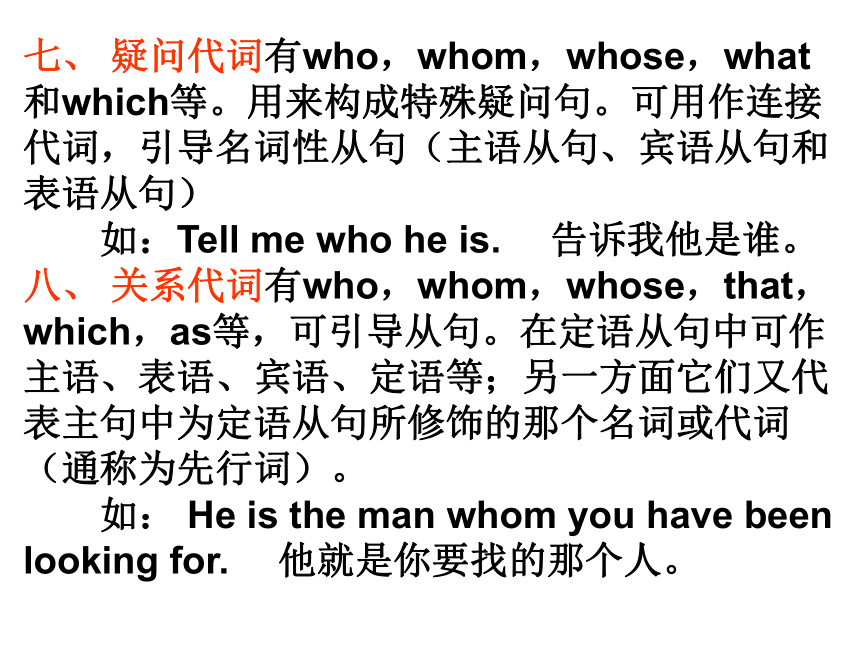
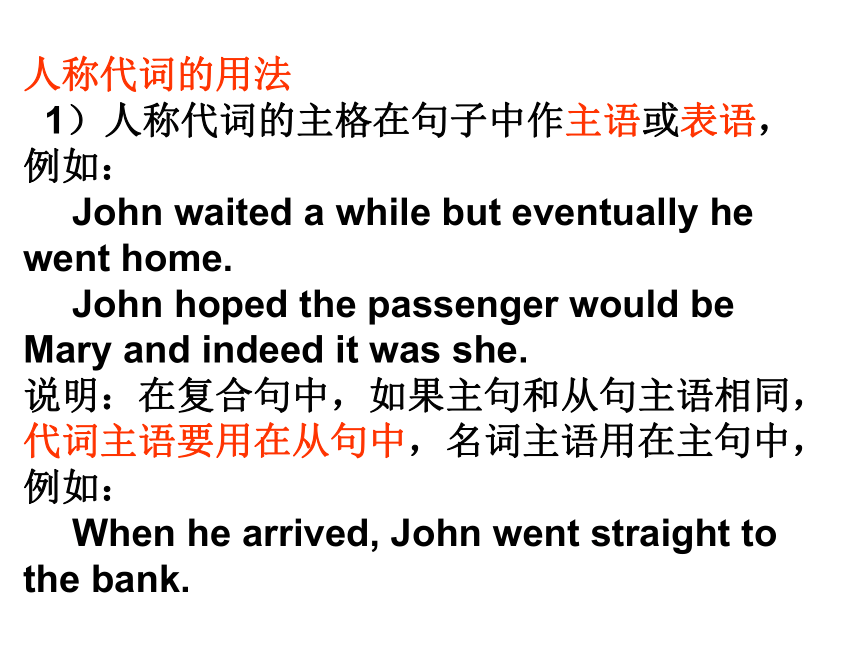

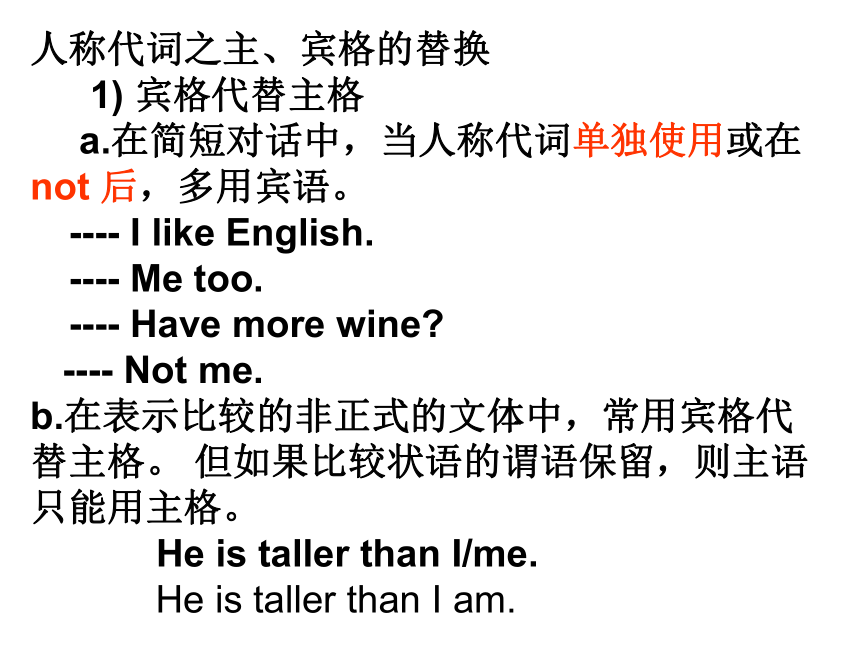

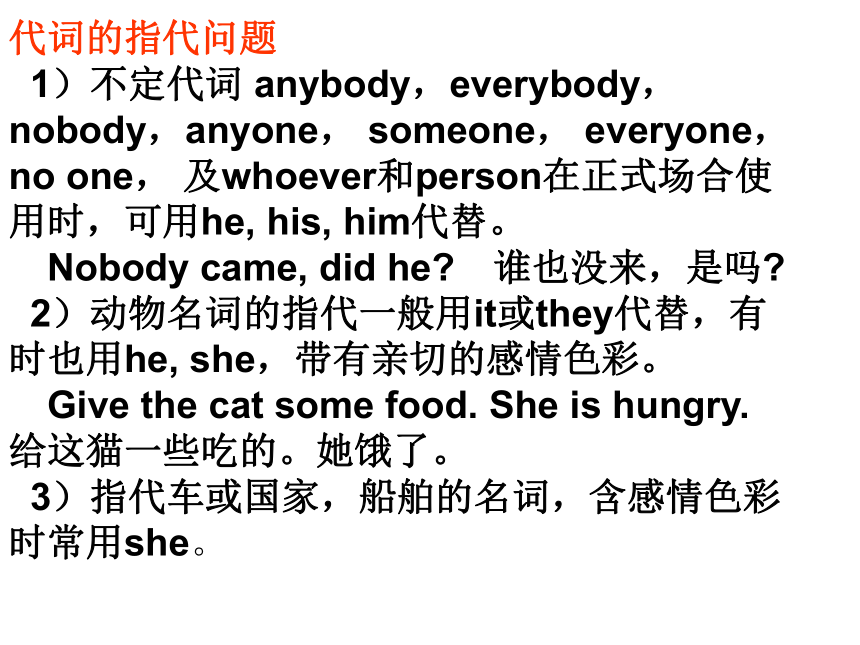
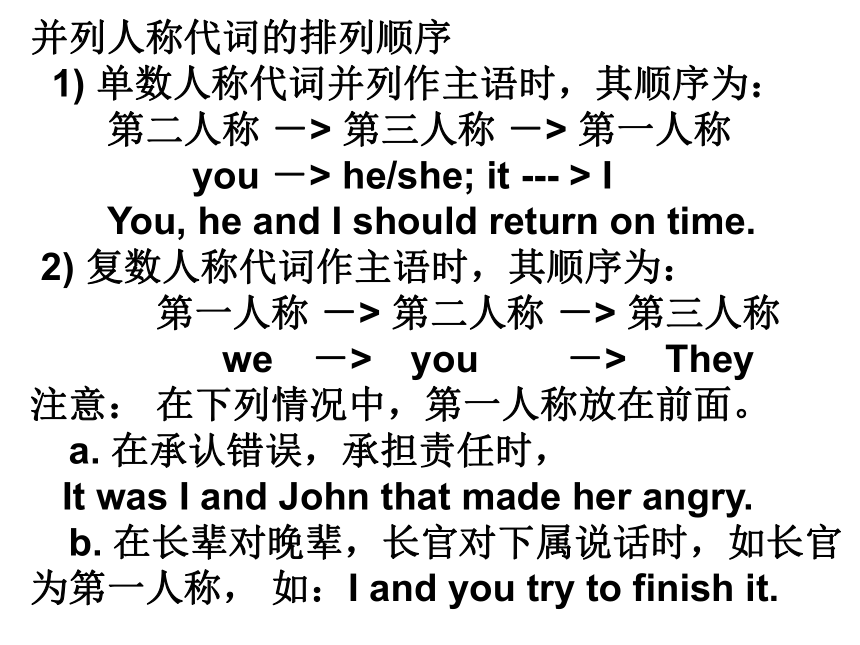
文档简介
课件41张PPT。 1代词是代替名词的一种词类。 2多数有名词和形容词的功能。 3人称~ 物主~ 指示~ 自身~、 相互~ 疑问~、 关系~ 不定~代词用法一、人称代词是表示“我”、“你”、“他”、“她”、“它”、“我们”、“你们”、“他们”的词。人称代词有人称、数和格的变化,见下表:
主格 宾格 主格 宾格
第一人称 I me we us
第二人称 you you you you
he him they them
第三人称 she her they them
it it they them
如: He is my friend.
It's me. 二、 物主代词(代词所有格)表示所有关系。
形容词性~ my your his/her its
our your their 名词性~ mine yours his/hers its
ours yours theirs 如: I like his car. Our school is here,and theirs is there. 三、 指示代词表示“那个”、“这个”、“这些”、“那些”。有this,that,these,those等.四、自身代词(反身代词)表示"我自己"、"你自己"、"他自己"、"我们自己"、"你们自己"和"他们自己"等。 如: She was talking to herself. 五、相互代词表示相互关系,有each other 和one another,没什么区别。 如: They love each other.六、1 不是指明代替任何特定名词的代词叫做不定代词。 2 有a11,both,each,every等,以及含有 some-,any-,no-等的合成代词,如 anybody, something,no one。 3 1)大都可以代替名词和形容词,作主语、宾语、表语和定语. 2) 但none和由some,any,no等构成的复合不定代词只能作主语、宾语或表语. 3) every和no只能作定语。如: --- Do you have a car? --- Yes,I have one. --- I don't know any of them. 七、 疑问代词有who,whom,whose,what和which等。用来构成特殊疑问句。可用作连接代词,引导名词性从句(主语从句、宾语从句和表语从句) 如:Tell me who he is. 告诉我他是谁。 八、 关系代词有who,whom,whose,that,which,as等,可引导从句。在定语从句中可作主语、表语、宾语、定语等;另一方面它们又代表主句中为定语从句所修饰的那个名词或代词(通称为先行词)。 如: He is the man whom you have been looking for. 他就是你要找的那个人。人称代词的用法 ??1)人称代词的主格在句子中作主语或表语,例如: John waited a while but eventually he went home. John hoped the passenger would be Mary and indeed it was she. 说明:在复合句中,如果主句和从句主语相同,代词主语要用在从句中,名词主语用在主句中,例如: When he arrived, John went straight to the bank.2)人称代词的宾格在句子中作宾语或介词宾语,但在口语中也能作表语,第一人称在省略句中,还可以作主语,例如: I saw her with them, at least, I thought it was her. (her做宾 语,them做介词宾语,her做表语) a. -- Who broke the vase? ? b. -- Me.(me做表语= It‘s me.) 说明:在上面两例句中,her和me分别作表语。现代英语中多用宾格,在正式文体中这里应为she和I。人称代词之主、宾格的替换 ?? 1) 宾格代替主格 a.在简短对话中,当人称代词单独使用或在not 后,多用宾语。 ---- I like English. ---- Me too. ---- Have more wine? ---- Not me. b.在表示比较的非正式的文体中,常用宾格代替主格。 但如果比较状语的谓语保留,则主语只能用主格。 He is taller than I/me. He is taller than I am.2) 主格代替宾格 a. 在介词but,except 后,有时可用主格代替宾格。 b. 在电话用语中常用主格。 ---- I wish to speak to Mary. ---- This is she.
注意:在动词be 或to be 后的人称代词视其前面的名词或代词而定。 I thought it was she. I thought it to be her. I was taken to be she. They took me to be her. 代词的指代问题 ??1)不定代词 anybody,everybody,nobody,anyone, someone, everyone,no one, 及whoever和person在正式场合使用时,可用he, his, him代替。 Nobody came, did he? 谁也没来,是吗? 2)动物名词的指代一般用it或they代替,有时也用he, she,带有亲切的感彩。 Give the cat some food. She is hungry. 给这猫一些吃的。她饿了。 3)指代车或国家,船舶的名词,含感彩时常用she。并列人称代词的排列顺序 ??1) 单数人称代词并列作主语时,其顺序为: 第二人称 -> 第三人称 -> 第一人称 you -> he/she; it --- > I You, he and I should return on time. 2) 复数人称代词作主语时,其顺序为: 第一人称 -> 第二人称 -> 第三人称 we -> you -> They 注意: 在下列情况中,第一人称放在前面。 a. 在承认错误,承担责任时, It was I and John that made her angry. b. 在长辈对晚辈,长官对下属说话时,如长官为第一人称, 如:I and you try to finish it.c. 并列主语只有第一人称和第三人称时, d. 当其他人称代词或名词被定语从句修饰时。 物主代词 ?1)物主代词既有表示所属的作用又有指代作用,例如: John had cut his finger; apparently there was a broken glass on his desk. 物主代词有形容词性(my, your等)和名词性(mine, yours等)两种,形容词性的物主代词属于限定词。 名词性的物主代词在用法上相当于省略了中心名词的 ‘s属格结构,例如: Jack’s cap 意为 The cap is Jack‘s. His cap 意为 The cap is his.2) 名词性物主代词的句法功能 a. 作主语,例如: May I use your pen? Yours works better. b. 作宾语,例如: I love my motherland as much as you love yours. c. 作介词宾语,例如: Your should interpret what I said in my sense of the word, not in yours. d. 作主语补语,例如: The life I have is yours. It's yours. It's yours. 我的生命属于你,属于你,属于你。 双重所有格 物主代词不可与 a, an, this, that, these, those, some, any, several, no, each, every, such, another, which等词一起前置,修饰一个名词,而必须用双重所有格。 a, an, this, that +名词+of +名词性物主代词。如: a friend of mine. each brother of his. 反身代词 I you you she he myself yourself yourselves herself himself we they it one ourselves themselves itself oneself
2)做宾语 a. 有些动词需有反身代词 absent, bathe, amuse, blame, dry, cut, enjoy, hurt, introduce, behaveWe enjoyed ourselves very much last night. 我们昨晚玩得很开心。
Please help yourself to some fish. b. 用于及物动词+宾语+介词 take pride in, be annoyed with, help oneself to sth. I could not dress (myself) up at that time. 注:有些动词后不跟反身代词, get up, sit-down, stand up, wake up等。 Please sit down. 请坐。
3) 作表语; 同位语 be oneself: I am not myself today.
The thing itself is not important. 4) 在不强调的情况下,but, except, for 等介词后宾语用反身代词或人称代词宾格均可。如: No one but myself (me) is hurt. 注意: a. 反身代词本身不能单独作主语。 (错) Myself drove the car. (对) I myself drove the car. b. 但在and, or, nor连接的并列主语中,第二个主语可用反身代词,特别是myself 作主语。 Charles and myself saw it. 5)第二人称作宾语,要用反身代词。 You should be proud of yourself. 相互代词 1)相互代词只有each other和one another两个词组。他们表示句中动词所叙述的动作或感觉在涉及的各个对象之间是相互存在的,例如: It is easy to see that the people of different cultures have always copied each other. 2) 相互代词的句法功能: a. 作动词宾语; People should love one another. b. 可作介词宾语; Does bark, cocks crow, frogs croak to each other. 说明:传统语法认为,相互关系存在于两个人或物之间用each other, 存在于两个以上人和物之间用one another。现代英语中,两组词交替使用的实例也很多,例如:He put all the books beside each other. He put all the books beside one another. Usually these small groups were independent of each other. c. 相互代词可加-‘s构成所有格,例如: The students borrowed each other’s notes. 指示代词 ?1) 指示代词分单数(this / that)和复数(these / those)两种形式,既可作限定词又可做代词,例如:
限定词:This girl is Mary. Those men are my teachers. 代词:This is Mary. Those are my teachers. 2) 指示代词的句法功能; a. 作主语 This is the way to do it. b. 作宾语 I like this better than that. c. 作主语补语 My point is this. d. 作介词宾语 I don't say no to that. There is no fear of that. 说明1: 指示代词在作主语时可指物也可指人,但作其他句子成分时只能指物,不能指人,例如: (对)That is my teacher. ( that作主语,指人) (对)He is going to marry this girl. (this作限定词) (错)He is going to marry this. (this作宾语时不能指人) (对)I bought this. (this指物,可作宾语)
说明2: That和those可作定语从句的先行词,但this和 these不能,同时,在作先行词时,只有those可指人,试比较: (对) He admired that which looked beautiful. (对) He admired those who looked beautiful. (those指人) (错) He admired that who danced well. (that作宾语时不能指人)(对) He admired those who danced well. (those指人) (对) He admired those which looked beautiful. (those指物)
疑问代词 ?1) 疑问代词在句中起名词词组的作用,用来构成疑问句。疑问代词有下列几个: 指 人: who, whom, whose 指 物: what 既可指人又可指物: which 2) 疑问代词在句中应位于谓语动词之前,没有性和数的变化,除who之外也没有格的变化。what, which, whose还可作限定词。试比较:疑问代词:Whose are these books on the desk? What was the directional flow of U. S. territorial expansion? 限定词:Whose books are these on the desk? What events led to most of the east of the Mississippi River becoming part of the United States?
说明1: 无论是做疑问代词还是限定词,which 和 what 所指的范围不同。what所指的范围是无限的,而which则指在一定的范围内,例如: Which girls do you like best? What girls do you like best? 说明2: Whom是who的宾格,在书面语中,它作动词宾语或介词宾语,在口语中作宾语时,可用who代替,但在介词后只能用whom, 例如: Who(m) did you meet on the street?(作动词宾语) Who(m) are you taking the book to?(作介词宾语,置句首) To whom did you speak on the campus?(作介词宾语,置介词 后,不能用who取代。)
说明3: 疑问代词用于对介词宾语提问时,过去的文体中介词和疑问代词通常一起放在句首,现代英语中,疑问代词在句首,介词在句未,例如:For what do most people live and work?(旧文体) What are you looking for?(现代英语)
说明4: 疑问代词还可引导名词性从句,例如: I can‘t make out what he is driving at. Can you tell me whose is the blue shirt on the bed? Much of what you say I agree with, but I cannot go all the way with you.
关系代词 1) 关系代词用来引导定语从句。它代表先行词,同时在从句中作一定的句子成分,例如:The girl to whom I spoke is my cousin(该句中whom既代表先行词the girl,又在从句中作介词to的宾语。)2) 关系代词有主格,宾格和属格之分,并有指人与指物之分。在限定性定语从句中,that 可指人也可指物,见表: 限定性 非限定性 限定性 指 人 指 物 指人或指物 主 格 who which that 宾 格 whom that that 属 格 whose of which/whose of which/whose 例如: This is the pencil whose point is broken. (whose 指物,在限定性定语从句中作定语)He came back for the book which he had forgotten.(which指物,在限定性定语从句中作宾语,可以省略)
3) 关系代词which的先行词可以是一个句子
He said he saw me there, which was a lie. 说明: 关系代词that在从句中作宾语或表语时可省略, 例如: I've forgotten much of the Latin I once knew. He's changed. He's not the man he was.
1)不定代词有 all , both, every, each, either, neither, more, little, few, much, many, another, other, some, any , one, no 以及some, something, anything, everything, somebody, someone, anybody, anyone, nothing , nobody, no one, none, everybody, everyone.等。
2) 不定代词的功能与用法 a. 除every 和no外不定代词既可用作名词,也可用作形容词。every和no在句中只能作定语。 I have no idea about it. b. all 都,指三者以上。 all 的主谓一致:all的单复数由它所修饰或指代的名词的单复数决定。 All goes well. all 通常不与可数名词单数连用,如:不说 all the book,而说 the whole book。 但all可与表时间的可数名词单数连用,如 all day,all night,all the year; 但习惯上不说 all hour,all century。all还可以与一些特殊的单数名词连用,如 all China, all the city, all my life, all the way 3) both 都,指两者。 a. both 与复数动词连用,但 both… and…可与单数名词连用。 b. both, all 都可作同位语,其位置在行为动词前, be 动词之后。如果助动词或情态动词后面的实义动词省 去,则位于助动词或情态动词之前。 Who can speak Japanese? We both (all) can. 4) neither 两者都不 a. neither作主语时,谓语动词用单数。
b. 作定语与单数名词连用,但neither… nor 用作并列连词,可与复数名词连用。其谓语采用就近原则。
c. 可用于下列句型,避免重复。She can't sing,neither (can) he.
neither 与nor d. 如前句是否定式从句,则主句用neither,而不用 nor。 If you don‘t do it,neither should I. 如果你不干,我也不干。
e. 如后连续有几个否定句式,则用nor,不用neither。 He can't sing,nor dance,nor skate.
none, few, some, any, one, ones ??一、 none 无 1) none作主语,多与of 构成短语 none of。 在答语中,none可单独使用。 Are there any pictures on the wall? None.2) none作主语,谓语动词单复数均可。但如做表语,则其单复数与表语一致。 It is none of your business.
二、few 一些,少数 few 作主语时,谓语动词用复数,多用于肯定句。 三、some 一些 1) 可与复数名词及不可数名词连用。 2) 当做"某一"解时,也可与单数名词连用。(= a certain) You will be sorry for this some day. A certain (some) person has seen you break the rule.
注意:(1)在肯定疑问句中用some代替any。 (2)some用于其他句式中:a. 肯定疑问句中:说话人认为对方的答案会是肯定的,或期望得到肯定回答时。 Would you like句式中,表委婉请求或建议,如: Would you like some coffee?
b. 在条件状语从句中表示确定的意义时,如: If you need some help,let me know.
c. some位于主语部分, Some students haven‘t been there before. d. 当否定的是整体中的部分时,some可用于否定句。如: I haven’t heard from some of my old friends these years. 四、any 一些
1)any 多用于否定句和疑问句和条件状语从句中。当句中含有任何的意思时,any可用于肯定句。 Here are three novels. You may read any. 五、one, ones 为复数形式 ones必须和形容词连用。如果替代的名词时无形容词在前,则用some, any,而不用ones。 Have you bought any rulers? Yes,I've bought some. 代词比较辩异 one,that 和it ?one表示泛指,that和it 表示特指。that与所指名词为同类,但不是同一个,而it 与所指名词为同一个。 I can't find my hat. I think I must buy one. (不定) The hat you bought is bigger than that I bought. (同类但不同个)I can't find my hat. I don' t know where I put it. ( 同一物) one/another/the other ?one… the other 只有两个 some… the others 有三个以上 one… another,another… some… others,others… others = other people/things the others = the rest 剩余的全部 1) 泛指另一个用another。 2) 一定范围内两人(物),一个用one,另一个用the other。 3) 一定范围内三者,一个用one,另一个用one (another),第三个可用the other,a third。4) 一定范围内,除去一部分人/物,剩余的全部用the others。 5) 泛指别的人或物时,用others当在一定范围内,除去一部分后,剩余部分但不是全部时,也用others。
anyone/any one;no one/none;every/each?? ?1.anyone 和 any one anyone仅指人,any one既可指人,也可指物。 2.no one 和none a) none 后跟of短语,既可指人又可指物,而no one只单独使用,只指人。 b) none 作主语,谓语动词用单,复数均可,而no one作主语谓语动词只能是单数。 None of you could lift it. 你们中没有人可举起它。 ---- Did any one call me up just now?---- No one. 3.every 和each 1) every 强调全体的概念, each强调个体概念。
Every student in our school works hard. 我们学校的学生都很用功。 Each student may have one book.. 每个学生都可有一本书。 2) every 指三个以上的人或物(含三个),each指两个以上的人或物 (含两个)。 3) every 只作形容词,不可单独使用。each可作代词或形容词。
Every student has to take one. Each boy has to take one. Each of the boys has to take one.4) every不可以作状语,each可作状语。 5) every 有反复重复的意思,如 every two weeks等; each没有。 6) every 与not 连用,表示部分否定; each 和not连用表示全部否定。 Every man is not honest. Each man is not honest. both, either, neither, all, any, none ??这些词都可用作代词或形容词。其位置都在be 动词之后,行为动词之前或第一助动词之后。 1) both (两者都),either(两者中任何一个), neither (两者都不)。以上词使用范围为两个人或物。 Neither of the two boys is clever. 2) both,either both与复数连用,either与单数连用。 Both the boys are clever. 两个男孩都很聪明。 Either of the two boys is clever. 两个男孩都很聪明。 There are flowers on both sides of the street. (两岸) There are flowers on either side of the street.(岸的两边) 3) all (所有的,全部的人或物),any (任何一个), none (都不)。 以上词使用范围为三者以上。 All the flowers are gone.
I don‘t like any of the flowers. I like none of the flowers. 注意:all与none用法一样。跟单数名词,用单数动词;跟复数名词,用复数动词。 All of the students are there. All (of) the milk is there. many, much?? ?Many,much都意为"许多", many + 可数名词,much + 不可数名词。 How many people are there at the meeting? How much time has we left? Many of the workers were at the meeting.
Much of the time was spent on learning. few, little, a few, a little (a) few + 可数名词, (a) little + 不可数名词 a few / a little 为肯定含义,还有一点few / little 为否定含义,没有多少了。 He has a few friends. 他有几个朋友。
He has few friends. 他几乎没有朋友。 We still have a little time. 我们还有点时间。 There is little time left.几乎没剩下什么时间了。
典型例题: Although he's wealthy,he spends___ on clothes. A. little B. few C. a little D. a few 答案: A. spend所指的是钱,不可数,只能用little或 a little. 本句为although引导的让步状语从句,由句意知后句为否定含义,因此应用little表示几乎不。固定搭配: only a few (=few) not a few (=many) quite a few (=many) many a (=many) Many books were sold. Many a book was sold. 卖出了许多书。
our your their 名词性~ mine yours his/hers its
ours yours theirs 如: I like his car. Our school is here,and theirs is there. 三、 指示代词表示“那个”、“这个”、“这些”、“那些”。有this,that,these,those等.四、自身代词(反身代词)表示"我自己"、"你自己"、"他自己"、"我们自己"、"你们自己"和"他们自己"等。 如: She was talking to herself. 五、相互代词表示相互关系,有each other 和one another,没什么区别。 如: They love each other.六、1 不是指明代替任何特定名词的代词叫做不定代词。 2 有a11,both,each,every等,以及含有 some-,any-,no-等的合成代词,如 anybody, something,no one。 3 1)大都可以代替名词和形容词,作主语、宾语、表语和定语. 2) 但none和由some,any,no等构成的复合不定代词只能作主语、宾语或表语. 3) every和no只能作定语。如: --- Do you have a car? --- Yes,I have one. --- I don't know any of them. 七、 疑问代词有who,whom,whose,what和which等。用来构成特殊疑问句。可用作连接代词,引导名词性从句(主语从句、宾语从句和表语从句) 如:Tell me who he is. 告诉我他是谁。 八、 关系代词有who,whom,whose,that,which,as等,可引导从句。在定语从句中可作主语、表语、宾语、定语等;另一方面它们又代表主句中为定语从句所修饰的那个名词或代词(通称为先行词)。 如: He is the man whom you have been looking for. 他就是你要找的那个人。人称代词的用法 ??1)人称代词的主格在句子中作主语或表语,例如: John waited a while but eventually he went home. John hoped the passenger would be Mary and indeed it was she. 说明:在复合句中,如果主句和从句主语相同,代词主语要用在从句中,名词主语用在主句中,例如: When he arrived, John went straight to the bank.2)人称代词的宾格在句子中作宾语或介词宾语,但在口语中也能作表语,第一人称在省略句中,还可以作主语,例如: I saw her with them, at least, I thought it was her. (her做宾 语,them做介词宾语,her做表语) a. -- Who broke the vase? ? b. -- Me.(me做表语= It‘s me.) 说明:在上面两例句中,her和me分别作表语。现代英语中多用宾格,在正式文体中这里应为she和I。人称代词之主、宾格的替换 ?? 1) 宾格代替主格 a.在简短对话中,当人称代词单独使用或在not 后,多用宾语。 ---- I like English. ---- Me too. ---- Have more wine? ---- Not me. b.在表示比较的非正式的文体中,常用宾格代替主格。 但如果比较状语的谓语保留,则主语只能用主格。 He is taller than I/me. He is taller than I am.2) 主格代替宾格 a. 在介词but,except 后,有时可用主格代替宾格。 b. 在电话用语中常用主格。 ---- I wish to speak to Mary. ---- This is she.
注意:在动词be 或to be 后的人称代词视其前面的名词或代词而定。 I thought it was she. I thought it to be her. I was taken to be she. They took me to be her. 代词的指代问题 ??1)不定代词 anybody,everybody,nobody,anyone, someone, everyone,no one, 及whoever和person在正式场合使用时,可用he, his, him代替。 Nobody came, did he? 谁也没来,是吗? 2)动物名词的指代一般用it或they代替,有时也用he, she,带有亲切的感彩。 Give the cat some food. She is hungry. 给这猫一些吃的。她饿了。 3)指代车或国家,船舶的名词,含感彩时常用she。并列人称代词的排列顺序 ??1) 单数人称代词并列作主语时,其顺序为: 第二人称 -> 第三人称 -> 第一人称 you -> he/she; it --- > I You, he and I should return on time. 2) 复数人称代词作主语时,其顺序为: 第一人称 -> 第二人称 -> 第三人称 we -> you -> They 注意: 在下列情况中,第一人称放在前面。 a. 在承认错误,承担责任时, It was I and John that made her angry. b. 在长辈对晚辈,长官对下属说话时,如长官为第一人称, 如:I and you try to finish it.c. 并列主语只有第一人称和第三人称时, d. 当其他人称代词或名词被定语从句修饰时。 物主代词 ?1)物主代词既有表示所属的作用又有指代作用,例如: John had cut his finger; apparently there was a broken glass on his desk. 物主代词有形容词性(my, your等)和名词性(mine, yours等)两种,形容词性的物主代词属于限定词。 名词性的物主代词在用法上相当于省略了中心名词的 ‘s属格结构,例如: Jack’s cap 意为 The cap is Jack‘s. His cap 意为 The cap is his.2) 名词性物主代词的句法功能 a. 作主语,例如: May I use your pen? Yours works better. b. 作宾语,例如: I love my motherland as much as you love yours. c. 作介词宾语,例如: Your should interpret what I said in my sense of the word, not in yours. d. 作主语补语,例如: The life I have is yours. It's yours. It's yours. 我的生命属于你,属于你,属于你。 双重所有格 物主代词不可与 a, an, this, that, these, those, some, any, several, no, each, every, such, another, which等词一起前置,修饰一个名词,而必须用双重所有格。 a, an, this, that +名词+of +名词性物主代词。如: a friend of mine. each brother of his. 反身代词 I you you she he myself yourself yourselves herself himself we they it one ourselves themselves itself oneself
2)做宾语 a. 有些动词需有反身代词 absent, bathe, amuse, blame, dry, cut, enjoy, hurt, introduce, behaveWe enjoyed ourselves very much last night. 我们昨晚玩得很开心。
Please help yourself to some fish. b. 用于及物动词+宾语+介词 take pride in, be annoyed with, help oneself to sth. I could not dress (myself) up at that time. 注:有些动词后不跟反身代词, get up, sit-down, stand up, wake up等。 Please sit down. 请坐。
3) 作表语; 同位语 be oneself: I am not myself today.
The thing itself is not important. 4) 在不强调的情况下,but, except, for 等介词后宾语用反身代词或人称代词宾格均可。如: No one but myself (me) is hurt. 注意: a. 反身代词本身不能单独作主语。 (错) Myself drove the car. (对) I myself drove the car. b. 但在and, or, nor连接的并列主语中,第二个主语可用反身代词,特别是myself 作主语。 Charles and myself saw it. 5)第二人称作宾语,要用反身代词。 You should be proud of yourself. 相互代词 1)相互代词只有each other和one another两个词组。他们表示句中动词所叙述的动作或感觉在涉及的各个对象之间是相互存在的,例如: It is easy to see that the people of different cultures have always copied each other. 2) 相互代词的句法功能: a. 作动词宾语; People should love one another. b. 可作介词宾语; Does bark, cocks crow, frogs croak to each other. 说明:传统语法认为,相互关系存在于两个人或物之间用each other, 存在于两个以上人和物之间用one another。现代英语中,两组词交替使用的实例也很多,例如:He put all the books beside each other. He put all the books beside one another. Usually these small groups were independent of each other. c. 相互代词可加-‘s构成所有格,例如: The students borrowed each other’s notes. 指示代词 ?1) 指示代词分单数(this / that)和复数(these / those)两种形式,既可作限定词又可做代词,例如:
限定词:This girl is Mary. Those men are my teachers. 代词:This is Mary. Those are my teachers. 2) 指示代词的句法功能; a. 作主语 This is the way to do it. b. 作宾语 I like this better than that. c. 作主语补语 My point is this. d. 作介词宾语 I don't say no to that. There is no fear of that. 说明1: 指示代词在作主语时可指物也可指人,但作其他句子成分时只能指物,不能指人,例如: (对)That is my teacher. ( that作主语,指人) (对)He is going to marry this girl. (this作限定词) (错)He is going to marry this. (this作宾语时不能指人) (对)I bought this. (this指物,可作宾语)
说明2: That和those可作定语从句的先行词,但this和 these不能,同时,在作先行词时,只有those可指人,试比较: (对) He admired that which looked beautiful. (对) He admired those who looked beautiful. (those指人) (错) He admired that who danced well. (that作宾语时不能指人)(对) He admired those who danced well. (those指人) (对) He admired those which looked beautiful. (those指物)
疑问代词 ?1) 疑问代词在句中起名词词组的作用,用来构成疑问句。疑问代词有下列几个: 指 人: who, whom, whose 指 物: what 既可指人又可指物: which 2) 疑问代词在句中应位于谓语动词之前,没有性和数的变化,除who之外也没有格的变化。what, which, whose还可作限定词。试比较:疑问代词:Whose are these books on the desk? What was the directional flow of U. S. territorial expansion? 限定词:Whose books are these on the desk? What events led to most of the east of the Mississippi River becoming part of the United States?
说明1: 无论是做疑问代词还是限定词,which 和 what 所指的范围不同。what所指的范围是无限的,而which则指在一定的范围内,例如: Which girls do you like best? What girls do you like best? 说明2: Whom是who的宾格,在书面语中,它作动词宾语或介词宾语,在口语中作宾语时,可用who代替,但在介词后只能用whom, 例如: Who(m) did you meet on the street?(作动词宾语) Who(m) are you taking the book to?(作介词宾语,置句首) To whom did you speak on the campus?(作介词宾语,置介词 后,不能用who取代。)
说明3: 疑问代词用于对介词宾语提问时,过去的文体中介词和疑问代词通常一起放在句首,现代英语中,疑问代词在句首,介词在句未,例如:For what do most people live and work?(旧文体) What are you looking for?(现代英语)
说明4: 疑问代词还可引导名词性从句,例如: I can‘t make out what he is driving at. Can you tell me whose is the blue shirt on the bed? Much of what you say I agree with, but I cannot go all the way with you.
关系代词 1) 关系代词用来引导定语从句。它代表先行词,同时在从句中作一定的句子成分,例如:The girl to whom I spoke is my cousin(该句中whom既代表先行词the girl,又在从句中作介词to的宾语。)2) 关系代词有主格,宾格和属格之分,并有指人与指物之分。在限定性定语从句中,that 可指人也可指物,见表: 限定性 非限定性 限定性 指 人 指 物 指人或指物 主 格 who which that 宾 格 whom that that 属 格 whose of which/whose of which/whose 例如: This is the pencil whose point is broken. (whose 指物,在限定性定语从句中作定语)He came back for the book which he had forgotten.(which指物,在限定性定语从句中作宾语,可以省略)
3) 关系代词which的先行词可以是一个句子
He said he saw me there, which was a lie. 说明: 关系代词that在从句中作宾语或表语时可省略, 例如: I've forgotten much of the Latin I once knew. He's changed. He's not the man he was.
1)不定代词有 all , both, every, each, either, neither, more, little, few, much, many, another, other, some, any , one, no 以及some, something, anything, everything, somebody, someone, anybody, anyone, nothing , nobody, no one, none, everybody, everyone.等。
2) 不定代词的功能与用法 a. 除every 和no外不定代词既可用作名词,也可用作形容词。every和no在句中只能作定语。 I have no idea about it. b. all 都,指三者以上。 all 的主谓一致:all的单复数由它所修饰或指代的名词的单复数决定。 All goes well. all 通常不与可数名词单数连用,如:不说 all the book,而说 the whole book。 但all可与表时间的可数名词单数连用,如 all day,all night,all the year; 但习惯上不说 all hour,all century。all还可以与一些特殊的单数名词连用,如 all China, all the city, all my life, all the way 3) both 都,指两者。 a. both 与复数动词连用,但 both… and…可与单数名词连用。 b. both, all 都可作同位语,其位置在行为动词前, be 动词之后。如果助动词或情态动词后面的实义动词省 去,则位于助动词或情态动词之前。 Who can speak Japanese? We both (all) can. 4) neither 两者都不 a. neither作主语时,谓语动词用单数。
b. 作定语与单数名词连用,但neither… nor 用作并列连词,可与复数名词连用。其谓语采用就近原则。
c. 可用于下列句型,避免重复。She can't sing,neither (can) he.
neither 与nor d. 如前句是否定式从句,则主句用neither,而不用 nor。 If you don‘t do it,neither should I. 如果你不干,我也不干。
e. 如后连续有几个否定句式,则用nor,不用neither。 He can't sing,nor dance,nor skate.
none, few, some, any, one, ones ??一、 none 无 1) none作主语,多与of 构成短语 none of。 在答语中,none可单独使用。 Are there any pictures on the wall? None.2) none作主语,谓语动词单复数均可。但如做表语,则其单复数与表语一致。 It is none of your business.
二、few 一些,少数 few 作主语时,谓语动词用复数,多用于肯定句。 三、some 一些 1) 可与复数名词及不可数名词连用。 2) 当做"某一"解时,也可与单数名词连用。(= a certain) You will be sorry for this some day. A certain (some) person has seen you break the rule.
注意:(1)在肯定疑问句中用some代替any。 (2)some用于其他句式中:a. 肯定疑问句中:说话人认为对方的答案会是肯定的,或期望得到肯定回答时。 Would you like句式中,表委婉请求或建议,如: Would you like some coffee?
b. 在条件状语从句中表示确定的意义时,如: If you need some help,let me know.
c. some位于主语部分, Some students haven‘t been there before. d. 当否定的是整体中的部分时,some可用于否定句。如: I haven’t heard from some of my old friends these years. 四、any 一些
1)any 多用于否定句和疑问句和条件状语从句中。当句中含有任何的意思时,any可用于肯定句。 Here are three novels. You may read any. 五、one, ones 为复数形式 ones必须和形容词连用。如果替代的名词时无形容词在前,则用some, any,而不用ones。 Have you bought any rulers? Yes,I've bought some. 代词比较辩异 one,that 和it ?one表示泛指,that和it 表示特指。that与所指名词为同类,但不是同一个,而it 与所指名词为同一个。 I can't find my hat. I think I must buy one. (不定) The hat you bought is bigger than that I bought. (同类但不同个)I can't find my hat. I don' t know where I put it. ( 同一物) one/another/the other ?one… the other 只有两个 some… the others 有三个以上 one… another,another… some… others,others… others = other people/things the others = the rest 剩余的全部 1) 泛指另一个用another。 2) 一定范围内两人(物),一个用one,另一个用the other。 3) 一定范围内三者,一个用one,另一个用one (another),第三个可用the other,a third。4) 一定范围内,除去一部分人/物,剩余的全部用the others。 5) 泛指别的人或物时,用others当在一定范围内,除去一部分后,剩余部分但不是全部时,也用others。
anyone/any one;no one/none;every/each?? ?1.anyone 和 any one anyone仅指人,any one既可指人,也可指物。 2.no one 和none a) none 后跟of短语,既可指人又可指物,而no one只单独使用,只指人。 b) none 作主语,谓语动词用单,复数均可,而no one作主语谓语动词只能是单数。 None of you could lift it. 你们中没有人可举起它。 ---- Did any one call me up just now?---- No one. 3.every 和each 1) every 强调全体的概念, each强调个体概念。
Every student in our school works hard. 我们学校的学生都很用功。 Each student may have one book.. 每个学生都可有一本书。 2) every 指三个以上的人或物(含三个),each指两个以上的人或物 (含两个)。 3) every 只作形容词,不可单独使用。each可作代词或形容词。
Every student has to take one. Each boy has to take one. Each of the boys has to take one.4) every不可以作状语,each可作状语。 5) every 有反复重复的意思,如 every two weeks等; each没有。 6) every 与not 连用,表示部分否定; each 和not连用表示全部否定。 Every man is not honest. Each man is not honest. both, either, neither, all, any, none ??这些词都可用作代词或形容词。其位置都在be 动词之后,行为动词之前或第一助动词之后。 1) both (两者都),either(两者中任何一个), neither (两者都不)。以上词使用范围为两个人或物。 Neither of the two boys is clever. 2) both,either both与复数连用,either与单数连用。 Both the boys are clever. 两个男孩都很聪明。 Either of the two boys is clever. 两个男孩都很聪明。 There are flowers on both sides of the street. (两岸) There are flowers on either side of the street.(岸的两边) 3) all (所有的,全部的人或物),any (任何一个), none (都不)。 以上词使用范围为三者以上。 All the flowers are gone.
I don‘t like any of the flowers. I like none of the flowers. 注意:all与none用法一样。跟单数名词,用单数动词;跟复数名词,用复数动词。 All of the students are there. All (of) the milk is there. many, much?? ?Many,much都意为"许多", many + 可数名词,much + 不可数名词。 How many people are there at the meeting? How much time has we left? Many of the workers were at the meeting.
Much of the time was spent on learning. few, little, a few, a little (a) few + 可数名词, (a) little + 不可数名词 a few / a little 为肯定含义,还有一点few / little 为否定含义,没有多少了。 He has a few friends. 他有几个朋友。
He has few friends. 他几乎没有朋友。 We still have a little time. 我们还有点时间。 There is little time left.几乎没剩下什么时间了。
典型例题: Although he's wealthy,he spends___ on clothes. A. little B. few C. a little D. a few 答案: A. spend所指的是钱,不可数,只能用little或 a little. 本句为although引导的让步状语从句,由句意知后句为否定含义,因此应用little表示几乎不。固定搭配: only a few (=few) not a few (=many) quite a few (=many) many a (=many) Many books were sold. Many a book was sold. 卖出了许多书。
